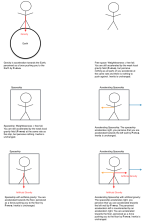AnotherDilbert
SOC-14 1K
Like the rest of anti-grav tech, it doesn't change inertia, it sets up a variable gravity field in the opposite direction of the perceived accel due to ship accel, i.e. it provides thrust, not inertia manipulation.
Note that acceleration compensators are often referred to as inertial compensators.Acceleration compensators are also usually installed, to negate the effects of high acceleration and lateral g forces while maneuvering.
There's a reason they stopped using the flat-rate formula for large ships and small craft.You are assuming a 5000 Dt starship would use the same reaction mass as a 20 Dt small craft, which would be a bit too much of a simplification for me...
Passive would be a neutralization of inertia.
Active would be equal countering.
If it changed inertial, you would feel no gravity = accel and when you moved you would bounce off the walls by the resulting accel. It changes neither mass nor inertia, of course.Of course it changes inertia, the clue is in the name and the description of what it does. And inertial mass = gravitic mass, if you can change one you can change the other.
Yet that is what it must be. The computers controlling it better be on the ball.Equal countering would mean you are pushed and pulled in different directions - could be messy
It doesn't change or affect inertia (= resistance to accel) in any way, it just accelerates you with the ship, in strict accordance with F=m×a. It manipulates F, not m.So what you have is the ability to produce artificial gravity and artificial inertia - inertia manipulation technology.
So what you have is the ability to produce artificial gravity and artificial inertia - inertia manipulation technology.
1. Local amplification?

Artificial gravity = inertial compensator, it's the same thing. Inertia never changes.
. . . not a pervasive "inertial dampening field". Otherwise you wouldn't get people jarred or thrown around by hits during combat either.
Yes, it's artificial gravity counteracting the perceived accel relative the ship, making you accel at the same rate as the ship, so you perceive no accel. Inertia is not changed or affected.I've always taken inertial compensation to be a high reaction-speed computer-controlled force-counterforce reaction keyed to engine output, not a pervasive "inertial dampening field".
Make it slightly more advanced and that is removed too.Otherwise you wouldn't get people jarred or thrown around by hits during combat either.
This has nothing to do with elastic collision, that is about the material of the colliding bodies?Which would also make internal damage difficult, as everything would be a perfectly elastic collision.
